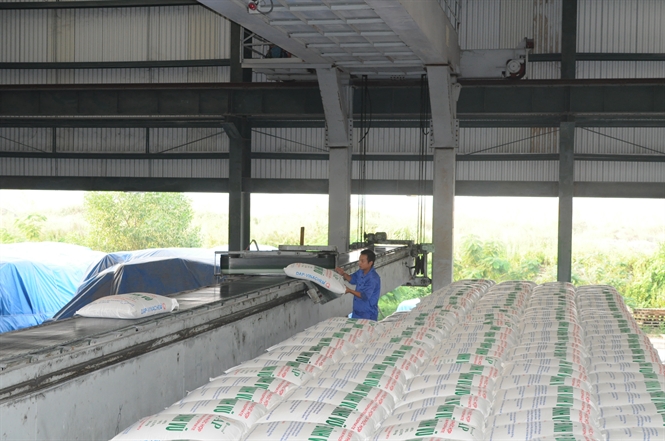Vinachem fertiliser plants amassing losses
 |
| Dinh Vu DAP fertiliser plant has been reporting continously losses (Source: Vinachem) |
Continuous losses
While some other fertiliser firms are reporting profit, DAP-Vinachem Co., Ltd. (ticker DDV on HoSE), a subsidiary of Vietnam National Chemical Group (Vinachem) operating Dinh Vu diammonium phosphate (DAP) fertiliser plant, recorded a loss in the first half of 2017.
In particular, although DDV’s revenue increased by 14.5 per cent over year, it still suffered a loss of VND55 billion ($2.42 million).
According to DDV’s leaders, despite a slight recovery, the company is still confronted with difficulties in product demand, declining selling prices, increasing loan interest rates, and so on.
Earlier, when forecasting business prospects for 2017, Nguyen Van Sinh, general director of DDV, said that its business in 2017 would not be smooth as the price of input materials would increase by nearly 30 per cent compared to the end of 2016.
DDV set the 2017 revenue target of more than VND2 trillion ($88 million) and profit target of VND1.2 billion ($52.8 million).
As of June 30, 2017, DDV suffered an accumulated loss of nearly VND521 billion ($22.9 million) and had an owners’ equity of VND944.6 billion ($41.6 million), while its chartered capital was over VND1.461 trillion ($64.3 million).
DDV’s total assets were more than VND2 trillion ($88 million), a reduction of 6 per cent compared to early 2017. Of the total, the short-term assets were more than VND503 billion ($22.1 million), accounting for 24 per cent of the total assets, and the long-term assets were VND1.534 trillion ($67.5 million), accounting for 76 per cent.
In 2016, Vinachem reported a record loss of VND470 billion ($20.68 million), a sharp growth compared to 2015.
DDV’s leaders said that the main reason for this loss is that fertiliser prices are declining while the cost of input materials is rising. Also, weak production cost management was mentioned for this failure.
Another Vinachem subsidiary in the fertiliser industry called DAP 2-Vinachem JSC operating Lao Cai DAP fertiliser plant reported even worse business results.
Besides objective problems of market surplus and fierce competition with foreign brands, high investment costs and limited product quality were the main reasons why the more Lao Cai DAP fertiliser plant produces, the worse its business results are.
Additionally, the Inspectorate under the Ministry of Construction and the State Audit have been constantly pointing out a wide range of serious violations in the investment and construction management of DAP 2-Vinachem JSC.
The total investment for Lao Cai DAP 2 fertiliser plant was nearly VND5.2 trillion ($228.8 million), a sizeable increase compared to the initial approved investment of more than VND4.4 trillion ($193.6 million).
Notably, from July 2015, when Lao Cai DAP was put into commercial operation, to June 30, 2016, the plant’s capacity did not reach the target.
In particular, from July 1, 2015 to December 31, 2015, the average capacity reached 65.2 per cent of the target. From January 1, 2016 to June 30, 2016, average capacity reached 43.5 per cent of the target.
In 2015, the plant suffered a loss of more than VND100 billion ($4.4 million), while in 2016, it was deep in a loss of over VND800 ($35.2 million).
Slim chances of recovery
Vinachem used to turn to the government to extend the maturity of its debts, reduce interest rates, apply tax to imported products, and so on, to save its four projects, including the two DAP plants.
From August 19, 2017, a temporary tax of VND1.85 million ($81.4) has been imposed on each tonne of imported DAP fertiliser. Nguyen Van Thanh, head of the Vietnam Chemicals Agency, said that this decision really benefits fertiliser manufacturers.
According to Thanh, this new policy will partly support loss-marking fertiliser plants like the Dinh Vu and Lao Cai DAP plants. Accordingly, Dinh Vu DAP may stop suffering losses if it can manufacture and sell 268,000 tonnes of DAP fertiliser.
The leader of a fertiliser plant in Ba Ria-Vung Tau said that the imposed tax on imported fertilisers can only support domestic fertiliser manufacturers so far, as their main problems are the high investment costs and inappropriate locations and technology, which lead to high production costs and low product quality.
MoIT said that the total losses of Vinachem DAP and DAP 2 are nearly equal to their owners’ equity and it is possible that in 2017 their owners’ equity may even turn negative. If the situation cannot change, these two plants will face high risk of closure.
What the stars mean:
★ Poor ★ ★ Promising ★★★ Good ★★★★ Very good ★★★★★ Exceptional
Latest News
More News
- PM sets January deadline for high-speed rail consultant (January 06, 2026 | 08:40)
- New decree spurs on PPP implementation (December 31, 2025 | 19:01)
- Global alliance develops $1 billion AI data centre network in Vietnam (December 30, 2025 | 10:08)
- Standing out in the Chinese outbound investment wave (December 29, 2025 | 10:29)
- Bright spots obvious in foreign investment mission (December 29, 2025 | 09:00)
- Ho Chi Minh City hits $8.37 billion in FDI (December 29, 2025 | 08:28)
- Vietnam and UK cooperation backs finance talent for IFCs (December 27, 2025 | 16:31)
- Global partnerships key to Vietnam’s IFC development (December 26, 2025 | 16:18)
- Vingroup pulls out of bid to invest in North-South high-speed railway (December 26, 2025 | 11:42)
- Strengthening supply chains through trade promotions and customs reform (December 24, 2025 | 14:00)
















 Mobile Version
Mobile Version